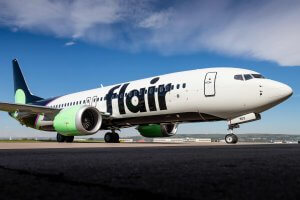Select Sidearea
Populate the sidearea with useful widgets. It’s simple to add images, categories, latest post, social media icon links, tag clouds, and more.


hello@youremail.com
+1234567890
+1234567890
Populate the sidearea with useful widgets. It’s simple to add images, categories, latest post, social media icon links, tag clouds, and more.


Iztok Franko

This interview is part of our exclusive ‘Airline Leaders Series,’ conducted in collaboration with Branchspace – digital reinvented, aiming to transform airlines into better digital retailers. Throughout the series, we’ll highlight the key concepts that are shaping modern airline digital retailing, ensuring you gain valuable insights from each discussion.
Leader: Juliana Ramirez
Airline: Flair Airlines
Role: VP Ancillary Revenue & Digital Experience
Location: Vancouver, Mexico City
Talks about: Retailing, Distribution, Ancillary Revenue, Merchandising, Digital Experience, Loyalty, Agile Organization

Why do you need to read this interview:
Juliana is a distinguished expert whose extensive experience spans low-cost airlines, ancillary revenue strategies, and e-commerce growth. Juliana’s unique position overseeing both ancillary revenue and digital experience offers readers a rare and comprehensive insight into the evolving landscape of airline commerce. Her expertise in travel distribution further enriches this interview, making it a treasure trove of knowledge for anyone keen to understand the synergies between digital transformation and revenue optimization in the airline industry. Juliana’s perspectives not only shed light on current trends but also hint at the future direction of airline retailing.
Juliana: Thinking about Flair as a ULCC (ultra low-cost carrier), it’s very simple. The goal of Flair airlines is to make travel affordable for everyone. Flair operates now in 5 countries: Canada, USA, Mexico, Jamaica, and Dominican Republic. Everything we do is focused on keeping our fares as low as possible for our customers. To keep our fares low, a key component, obviously – is ancillary revenue, digital and retailing strategy.
The goal continues to be a hyper focused on unbundling our fare and strengthen our ancillary revenue offering. Essentially delivering the right product at the right time, with the right price point, in the right channel. How do you differentiate your direct channel so that you can drive more customers? How do you drive those customers to get their data points? How do you know the customers’ needs so that you can price the product, whether it be the bundle, the guarantee, the seat, etc., exactly when they need it?
Sometimes it sounds very repetitive, but I think the goal for us at Flair is to continue to be super aggressive on our retailing strategy, to continue to deliver the lowest available fares in Canada, to be the most reliable and affordable choice in air travel in the routes and regions we operate.
Juliana: Ancillary is digital, and digital is ancillaries. One of the key, in my opinion, competitive advantages of ultra low-cost carriers is how they create the organizational structure and collaboration between ancillaries, distribution, ecommerce, and digital marketing. In this case, I own both of the pieces of the pie.
In this case, my teams are in charge of ecommerce, ancillaries, digital and distribution alongside strong teamwork withing revenue management and marketing, resulting in a extremely agile environment, which is paramount in a competitive environment.Every single online touchpoint that the customer touches is also the most important piece of the ancillary and distribution strategy. So I think one of our competitive advantages is exactly that, we move very fast at Flair.
Usually in organizations you will see competing agendas or initiatives where proving your argument takes time and time is money. As a result you compete with an A/B test for cross-selling a seat or a checked bag versus an optimization on how to sell the specific flight on the flights page, or X initiative, resulting in less flexibility and speed to action. What you see from a ULCC perspective, where a big chunk of your revenues come from ancillaries – and not only that, but ancillaries are the ones that enable growth to deliver the lowest fares – flexibility is crucial. So, I think ancillaries, digital, and distribution is a common denominator in every area.
And as much as the organization can keep them not specifically in a single leader, but with a single agenda, this enables, for example, Flair to move faster. Obviously we’re growing, we’re having more routes, more customers, more visits on our website, and the challenge becomes, how do you keep hyperfocus on the core components of your digital journey while continuing to expand?
I think if you keep that similar focus between digital, distribution and ancillaries, this will eventually enable a more agile and nimble organization.
Juliana: Talking about ancillary revenue I would say four key initiatives.

Source: Flair Airlines
Juliana: The million dollar question, right? You and I always read about these things. More than a technology, I would say a trend. It’s a trend that I’ve been seeing evolving not only in the last years, but even before COVID. And that is distribution capabilities. It goes hand in hand with the origin of our conversation. Distribution not only in the airline industry, but in travel tech, is core, and I think it has a lot of opportunities ahead.
You see new players – not only airlines, but OTAs, aggregators, meta, searchers, and obviously direct products like airlines, hotels, activity providers, vacation brands – navigating more and more into the problems of distribution, and then on top of it you also see these middle layers of players that are digging deeper into the NDC capabilities, with a strong focus to cut the middle man to capture more value.
From a ULCC perspective, obviously we want to capture more direct channel. We want to have the user locked in our website because direct is the cheapest distribution channel, and it also enhances our full product portfolio and clarity on what we are and what we stand for, which is the lowest fares, versus the customer booking on an indirect channel or an indirect OTA that probably has no clue on what the policy of the airline is. You want more traffic in your direct channel, also to learn about the customer and be able to give them the right service and the right product at the right time, with the right price.
I guess the big “watch out” and the big trend is distribution. Watch how other players and third parties vendors are distributing flights, rooms or car rental is key. For example offerings like virtual interlining in third parties are very interesting, overall, where defining the acquisition strategy is crucial. Who wins the customer to their channels, to me, is core not only for airlines but for every single online travel commerce.
Juliana: I would say maybe not the biggest, but one of the biggest for sure, and not only for this year. In my years in the industry, I always see a new different player coming up and challenging the distribution locally, globally, or even the full travel tech landscape. But the industry has so many opportunities for that. You see more and more distribution wars chasing for lowest fares: agents, bots, aggregators, you name it, crawling on your channels direct and indirect hunting everywhere. You have to have strong reporting tools and datapoints to really understand the network effects, not to mention prevention tools and proper infrastructure.
And technology is evolving, so I think all the leaders on distribution and digital need to be very sharp on having the right data dashboards in their hands to be able to take informed decisions that would rally their strategy. Yeah, this is definitely one of the trends / challenges that I see and continue to see.
Loyalty is a trend and a challenge as well. How do you think about repeated business for your customers?
How do you continue to deliver the lowest fare in the market, but also, how do you win not only the flight but the maximum share of wallet in general? Customers, when they travel for either leisure, business, pleasure, visit friends and relatives, staycation, anniversary, whatever, are also spending more money somewhere in their desinations. How do you really capture that value in a hyperconnected world with so many loyalty programs out there? Loyalty is also very intertwined with distribution. So definitely loyalty, distribution, and the ever-changing needs of our customers.
Juliana: I see two pointers. For retailing, what we were discussing offline – what I see is that those who have high quality integrated data win –if that information is digestible and understandable, the power is infinite. And when you think about AI, for sure it’s so much needed.
To me, in the most basic principles, AI has increased productivity big time. I still think that we need smart use cases. That mix between experienced or creative individuals with a use case, where AI would enhance the time to market for and fill in the gaps that many entrepreneurs and founders have been seeking. We’ve been talking many years about chatbots, but really the productivity that a chatbot with AI is gathering now is so much better. The lead times of launching an MVP are way faster.
But I do feel that the challenge is really to build these specific use cases on a specific need and then work collaboratively to test the hypothesis with AI. Hopefully we’re going to see more and more of these use cases for distribution, for loyalty, for booking, but also for operational issues – customer service, time to respond, and obviously cross-selling and understanding additional levers for how to capture more share of wallet of not only your customers, but your website visitors or your footprint in general.
If you want to learn from leaders like Juliana about how to advance your airline digital retailing or want to be the first to know when our next Airline Digital Talk will be published, please:
I am passionate about digital marketing and ecommerce, with more than 10 years of experience as a CMO and CIO in travel and multinational companies. I work as a strategic digital marketing and ecommerce consultant for global online travel brands. Constant learning is my main motivation, and this is why I launched Diggintravel.com, a content platform for travel digital marketers to obtain and share knowledge. If you want to learn or work with me check our Academy (learning with me) and Services (working with me) pages in the main menu of our website.
Download PDF with insights from 55 airline surveyed airlines.
Thanks! You will receive email with the PDF link shortly. If you are a Gmail user please check Promotions tab if email is not delivered to your Primary.
Seems like something went wrong. Please, try again or contact us.


paul byrne
Very insightful, Juliana. Thanks for sharing your perspectives.